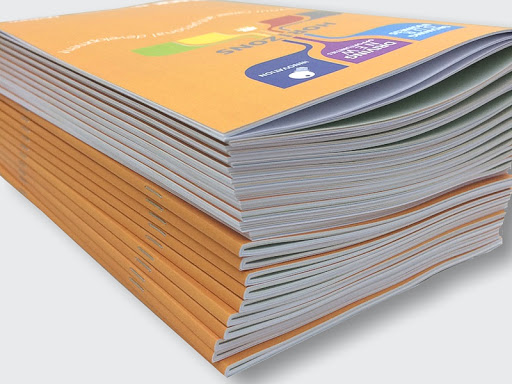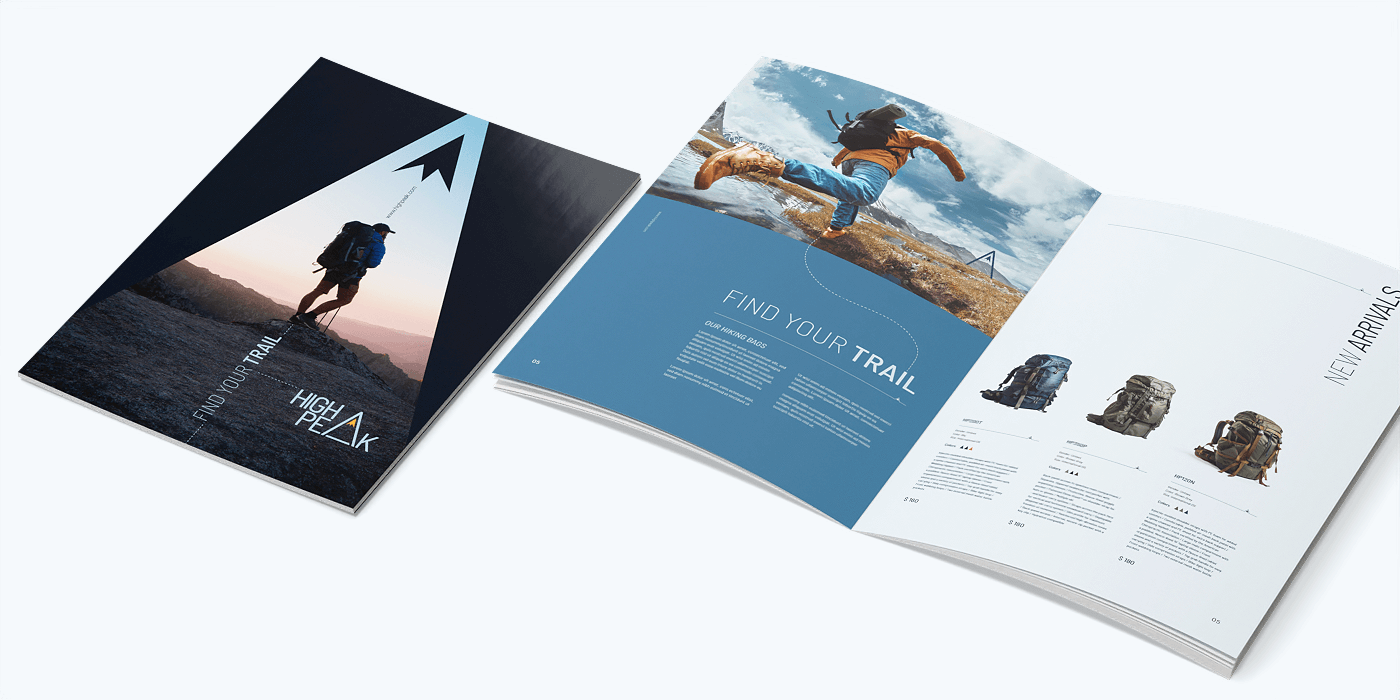Why Eco-Friendly Booklet Printing Is the Future of Sustainable Marketing
Why Eco-Friendly Booklet Printing Is the Future of Sustainable Marketing
Blog Article
The Essential Overview to Understanding Pamphlet Printing Options and Techniques
The process of booklet printing includes multiple factors to consider that can considerably affect the final item. From choosing the suitable style and size to comprehending the subtleties of binding methods, each option plays a vital role. Additionally, variables such as paper supply and printing strategies additional influence the performance of the brochure. As one browses these alternatives, it comes to be critical to comprehend how they adjoin and what that indicates for the overall result.
Recognizing Brochure Formats and Dimensions
When considering brochure printing, recognizing the various styles and dimensions readily available is vital for attaining the preferred discussion. Booklets can be generated in numerous styles, including saddle-stitched, spiral-bound, and perfect-bound, each offering distinctive advantages. Typical dimensions range from conventional letter (8.5 x 11 inches) to smaller sized choices like A5 (5.8 x 8.3 inches), permitting for flexibility based on material and target audience.Selecting the appropriate size can affect both the format and reader interaction. Larger dimensions could suit visually driven material, while smaller layouts might be much more mobile and straightforward. Additionally, the number of pages impacts the option of binding approach, as thicker booklets may need stronger bindings. Eventually, understanding these elements enables for an extra customized approach, making sure that the last item aligns with the intended message and aesthetic, enhancing the overall performance of the communication.
Selecting the Right Paper Supply

Binding Approaches: Alternatives and Factors To Consider
When it pertains to binding techniques for pamphlets, numerous choices are readily available, each with distinct benefits. Saddle stitch binding supplies an economical option for thinner booklets, while perfect binding strategies provide a more sleek look for thicker magazines. Wire-O binding sticks out for its toughness and simplicity of use, making it excellent for documents that require adaptability.
Saddle Stitch Binding
Saddle stitch binding offers a affordable and useful service for constructing pamphlets, making it a preferred selection amongst organizations and authors. This binding technique includes folding sheets of paper in half and stapling them along the fold line, creating a cool and well organized look. Generally appropriate for booklets with a reduced page matter, saddle sewing is ideal for publications, sales brochures, and training products. The simpleness of this technique allows for fast production and is typically favored for promotional products or short runs. However, it is important to keep in mind that saddle stitch binding may not be suitable for thicker pamphlets, as the back may not stand up under boosted weight. Overall, it stays a reputable option for several printing jobs.
Perfect Binding Strategies
Perfect binding is a widely made use of method that gives a refined and professional finish to publications and pamphlets. This method entails gluing the web pages with each other at the spine utilizing a solid adhesive, allowing for a tidy side and the ability to hold a bigger variety of pages contrasted to saddle sewing. Perfect binding is particularly appropriate for thicker pamphlets, such as brochures and yearly records, where a durable, level back is desired. Furthermore, it supplies the option for a printed cover that can be created to enhance visual charm. Nonetheless, factors to consider such as page count, paper weight, and the meant usage of the booklet ought to be thought about, as they can influence sturdiness and total top quality.
Wire-O Binding Alternatives
Wire-O binding, recognized for its durability and flexibility, provides an outstanding choice for brochures that need simple page turning and an expert appearance. This binding method employs a series of steel loopholes that hold web pages firmly, enabling them to lie flat when open. It is especially suitable for presentations, manuals, and catalogs as a result of its durable nature. Wire-O binding is offered in various shades and sizes, accommodating various web page counts and densities. In addition, it permits the incorporation of covers and tabs, improving the brochure's general visual. Considerations for Wire-O binding consist of the selection of wire color, the dimension of the loopholes, and the degree of modification wanted, all of which can profoundly influence the final product's look and functionality.
Digital vs. Offset Printing: Which Is Best for You?
When choosing a printing approach for pamphlets, understanding the differences in between electronic and counter printing is crucial. Digital printing utilizes modern-day innovation to generate top notch prints swiftly and economically, making it perfect for short runs or jobs needing quick turn-around times. It enables customization, giving the capacity to publish on-demand with minimal waste.In contrast, counter printing is a standard approach that masters generating large amounts with consistent top quality. It entails moving ink from a plate to a rubber blanket, then to the paper, which leads to precise information and dynamic colors. Balance out printing typically calls for longer setup times and is much more economical for bigger volumes.Ultimately, the option between digital and balance out printing depends on project demands, budget, and preferred quantity. For little, time-sensitive jobs, digital could be the most effective option, while balanced out might be more suitable for larger, premium productions.

Creating Your Pamphlet: Tips and Finest Practices
When creating a pamphlet, careful focus to design, font selection, and color usage can greatly boost its effectiveness. A well-structured design guides the visitor's eye, while ideal typefaces ensure readability and communicate the wanted tone. Furthermore, reliable use shade can evoke emotions and highlight key info, making the general design extra impactful.
Choosing the Right Layout
Just how can one properly pick the right format for a brochure? Initially, it is vital to review the booklet's purpose and target market. A tidy, arranged layout improves readability and engagement. Using a grid system can help in aligning aspects regularly, developing a professional look. In addition, integrating aesthetic power structure with varying sizes and placements of photos and text can assist the viewers's eye and highlight crucial information. It is likewise essential to leave sufficient white area, which protects against congestion and permits much better emphasis. Finally, evaluating various formats through mock-ups can offer understanding right into just how the design carries out in real-world situations, making certain that the end product satisfies both visual and useful requirements.
Picking Ideal Typefaces
An appropriate typeface can substantially enhance the overall layout of a pamphlet, enhancing the format and enhancing the web content's message. The option of font styles must think about readability, particularly for body text, as it guarantees the information comes to all readers. Sans-serif typefaces are often favored for electronic styles, while serif font styles can lend a traditional feeling in published materials. It's advisable to restrict font options to two or three to keep visual comprehensibility. In addition, font style size plays an essential duty; headings ought to be not overwhelming yet unique, while body message should be comfortable for analysis. When picking typefaces, alignment with the pamphlet's motif and target market is important for efficient interaction and visual allure.
Reliable Usage of Color
Color acts as a powerful device in brochure layout, shaping assumptions and directing viewers emotions. It can evoke sensations of trust, calmness, or that site exhilaration, depending upon the tones website link selected. Designers must consider color theory concepts, guaranteeing that the selected scheme straightens with the booklet's message and target audience. Utilizing warm shades like red and orange can produce necessity, while cooler tones like blue and environment-friendly foster tranquility.Additionally, comparison plays a vital function; complementary shades can enhance readability and visual appeal. Consistency in color usage throughout web pages better strengthens brand name identity and cohesion. Ultimately, effective shade execution not just records focus yet additionally enhances the pamphlet's function, making it a crucial facet of successful style.
Finishing Touches: Coatings and Special Results
While several take into consideration the material and layout of a booklet one of the most essential aspects, the completing touches, such as finishings and special impacts, play a vital role in boosting its general charm. Coatings can provide defense and durability, ensuring that the pamphlet stands up to wear and tear. Matte coatings use a sophisticated, non-reflective surface, while glossy coatings can make shades appear even more eye-catching and vivid. Special results, like embossing or foil marking, add a tactile measurement that can produce a memorable impact. These techniques can highlight details areas, attracting focus to essential details or producing aesthetic interest. In addition, UV covering can offer a high-shine coating that elevates the total look.Together, these finishing touches not only boost the booklet's visual however additionally communicate expertise and interest to information, ultimately leaving an enduring effect on the visitor.
Price Considerations for Booklet Printing
Comprehending the numerous price considerations for brochure printing is crucial for businesses and organizations intending to maximize their budget plans. Trick factors influencing expenses include the option of binding, paper, and ink techniques. Higher high quality materials, such as superior paper or specialized inks, commonly increase the overall expense. Furthermore, the size and web page matter of the pamphlet play a significant role; larger booklets require more sources and time to produce.Another important consideration is the printing technique, whether digital or offset, as each has its own pricing structure and suitability for different quantities. Companies ought to also consider layout find out here costs, which can differ based on complexity and the usage of professional solutions. Inevitably, delivery and handling costs can contribute to the overall, specifically for big orders. By examining these aspects, organizations can make informed choices that straighten with their economic capacities while accomplishing the preferred quality in their published products.
Often Asked Concerns
What Are the Environmental Impacts of Pamphlet Printing?
The ecological impacts of booklet printing include deforestation from paper manufacturing, carbon exhausts from transportation, and waste generation from discarded products - Booklet Printing. Sustainable techniques, such as using recycled paper and eco-friendly inks, can minimize these impacts
How Can I Make Certain Color Accuracy in My Pamphlet?
To ensure color precision in a booklet, one need to use calibrated displays, utilize professional shade profiles, carry out test prints, and pick top quality printing services that use color matching and proofing alternatives for best outcomes.
What Is the Common Turnaround Time for Booklet Printing?
The regular turnaround time for pamphlet printing varies relying on the complexity and amount - Booklet Printing. Generally, it ranges from a couple of days to two weeks, affected by factors such as printing approaches and finishing demands
Exist Minimum Order Quantities for Brochure Printing?

Can I Print Brochures in Several Languages?
Printing brochures in several languages is feasible. Lots of printing solutions supply alternatives for multilingual or multilingual formats, permitting reliable interaction. Mindful preparation warranties that create components fit different languages without jeopardizing readability or visual appeals. Furthermore, elements such as paper stock and printing strategies more affect the performance of the brochure. When thinking about brochure printing, understanding the different styles and dimensions offered is crucial for attaining the preferred presentation. When selecting a printing approach for pamphlets, comprehending the differences between electronic and counter printing is important. In addition, the dimension and page count of the pamphlet play a considerable role; larger booklets need more sources and time to produce.Another crucial consideration is the printing technique, whether electronic or balanced out, as each has its very own prices structure and viability for different amounts. The ecological impacts of pamphlet printing include logging from paper production, carbon exhausts from transportation, and waste generation from discarded materials.
Report this page